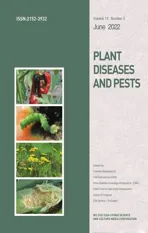Grafting and Seedling Cultivation Technology of Cherry Tomato for Disease Prevention in Hainan
2022-12-28ZijiLIUWeixiaLIUYulingQINYanYANG
Ziji LIU, Weixia LIU, Yuling QIN, Yan YANG
Tropical Crops Genetic Resources Institute, Chinese Academy of Tropical Agricultural Sciences, Haikou 571101, China
Abstract In order to reduce the occurrence of soil-borne diseases, such as tomato bacterial wilt and Fusarium wilt, and to improve the yield of cherry tomato in Hainan, the paper had summarized grafting and seedling technology of cherry tomato from the aspects of rootstock selection, rootstock seedling cultivation, scion seedling cultivation, preparation before grafting, grafting method and seedling management after grafting. It was found that the technique could significantly improve the yield and disease resistance of cherry tomato.
Key words Cherry tomato; Casing grafting; Grafting and seedling cultivation
1 Introduction
Cherry tomato is a kind of fruit tomato with high economic value because of diversified fruit shape and color, sweet and slightly sour taste, and rich nutrition[1]. In recent years, the planting area of cherry tomato in Hainan Province is constantly expanding, while soil-borne diseases are becoming more and more serious, resulting in a significant decline in yield and seriously restricting the development of cherry tomato industry. Grafting seedling cultivation is an important approach to prevent soil-borne diseases such as tomato bacterial wilt andFusariumwilt[2-4]. Compared with other technologies, it has the advantages of less investment, short cycle and quick effect[5-6]. Casing grafting method can significantly improve tomato yield and enhance disease resistance[7-8]. This paper summarized casing grafting and seedling cultivation technology of cherry tomato, in order to provide technical support for the production of cherry tomato in Hainan.
2 Rootstock selection
The rootstock is improved ‘Solanumtorvum’, and it has high affinity, vigorous root system and high resistance to bacterial wilt,Fusariumwilt and root-knot nematode.
3 Rootstock seedling
The rootstock seeds are soaked in 55 ℃ warm water for 30 min and stirred continuously until the temperature is cooled to 30 ℃. After soaked in 1 000 mg/L gibberellin solution for 48 h, the seeds are taken out and placed in a 4 ℃ refrigerator for 2 h, and then placed in a 30 ℃ incubator for germination. After 3-4 d when 80% seeds are germinated, the seeds are sown on sand bed to raise seedlings. When the rootstock grows to two-leaf and one-heart stage after 30 d, the seedlings are transplanted to 72-well seedling tray. At 15 d after transplanting, 0.3% compound fertilizer (N∶P∶K=15∶15∶15) is applied for root irrigation. Grafting is usually carried out when there are 5-7 leaves (about 55-60 d).
4 Scion seedling cultivation
The scion is cherry tomato variety ‘Millennium’, and the seeds are soaked in 0.1% potassium permanganate solution for 10-15 min after germination of rootstock seeds (about 20-25 d). The seeds are washed and soaked in 1 000 mg/L gibberellin solution at room temperature for 24 h, and the germination is accelerated at 30 ℃ for 2 d. The seeds are sown to 60- or 72-well seedling tray, and grafting is usually carried out when there are 4-6 leaves (about 35 d).
5 Preparation before grafting
Scion seedlings are sprayed with kasugamycin or agricultural streptomycin, mancozeb and other agents 3-5 d prior to grafting.
Rootstock seedlings are irrigated with metalaxyl, hymexazol and other agents 3-5 d prior to grafting, and are watered sufficiently 1 d prior to grafting.
6 Grafting method
When the rootstock grows to 5-7 true leaves and there are 4-6 true leaves on scion, grafting can be performed. Casing grafting method is adopted, and the grafting site should be overshadowed. Grafting tools mainly include double-sided blades, thin round tubes,etc.The rootstock is cut at an equal angle of 45° on the whole seedling tray. Scion seedlings of the same size are selected according to the stem diameter of rootstock, and the slant of scion seedlings is consistent with that of rootstock. Then the thin tube is first connected with the rootstock, and the cut scion seedlings are connected with the slant of the rootstock.
7 Seedling management after grafting
Small plastic shed+plastic film+sunshade net (shading rate more than 90%) is set in the greenhouse for shading. After grafting, the seedlings are immediately moved into small plastic shed. The small plastic shed is closed from the 1stto 3rdd (if it is cloudy or rainy, the sunshade net is opened for light transmission). The shading net and film on both sides of the small plastic shed should be opened in the morning and evening from the 4thto 6thd for appropriate ventilation and light transmission. Water is supplemented according to the needs of seedlings, and watering is generally performed before 10:00 in the morning. The shading net and film on small plastic shed should be opened in the morning and evening from the 7thto 10thd, and the shading net should still be covered at noon. All shading nets and films on small plastic shed are uncovered from the 10thto 14thd, and 0.3% potassium dihydrogen phosphate foliar fertilizer is applied at this stage to promote strong seedlings. Seedlings are acclimatized from the 15thto 18thd, which can be transplanted after normal management.
杂志排行
植物病虫害研究(英文版)的其它文章
- Doing a Good Job in Inspection and Maintenance of Facilities and Equipments in Bulk Curing Barn
- Tomato Green Cultivation Technology of Reducing Fertilizer and Pesticide Input and Increasing Fertilizer Efficiency
- Occurrence Regularity and Life History of Cigarette Beetle Lasioderrma serricorne (Fabricius) in Tobacco Leaf Threshing and Redrying Workshop
- Observation on Behavior of Chilades pandava
- Field Identification and Prevention and Control Techniques of Citrus Huanglongbing of Orah Mandarin
- Field Control Effects of Four Biopesticides on Grape Gray Mold
